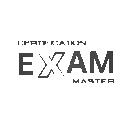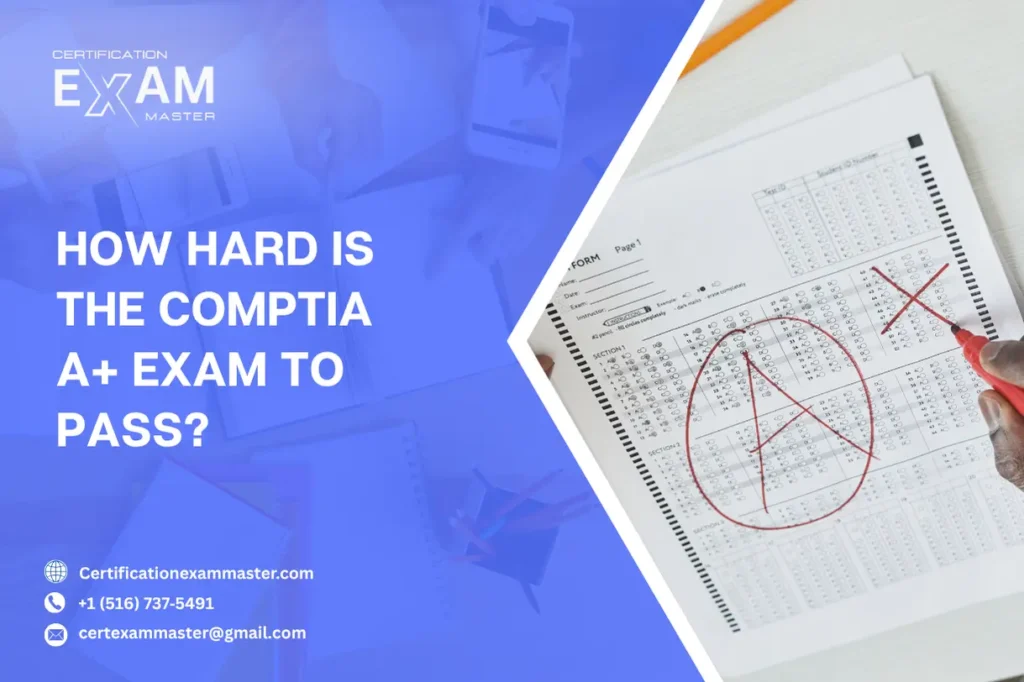Aspirants seeking IT certification often wonder about the difficulty level of the CompTIA A+ exam. This inquiry is natural, given the exam’s reputation as a foundational step in IT careers.
The CompTIA A+ certification is a crucial milestone for individuals entering the IT industry. It validates a broad range of skills necessary for a successful IT career. However, the path to achieving this certification can be daunting.
Certification Exam Master is designed to help you overcome the challenges of the CompTIA A+ exam. By understanding what to expect and guaranteeing a pass, you can boost your confidence and increase your chances of success.
Understanding the CompTIA A+ Certification
Understanding the CompTIA A+ certification process is crucial for aspiring IT professionals. This certification is a foundational credential that validates an individual’s skills in installing, configuring, and troubleshooting computer systems.
What Is CompTIA A+ and Why Does It Matter
CompTIA A+ is an entry-level certification that covers a broad range of IT topics, including hardware, software, networking, and security. It matters because it is often a requirement for entry-level IT positions and demonstrates a level of competence in IT.
The certification is vendor-neutral, meaning it is not specific to any one company’s products, making it a versatile credential.
The Two-Exam Structure: Core1 and Core2
The CompTIA A+ certification requires passing two exams: Core1 (220-1001) and Core2 (220-1002). These exams test a candidate’s knowledge and skills in various IT areas.
- Core1 (220-1001): Covers hardware, networking, mobile devices, and troubleshooting.
- Core2 (220-1002): Focuses on software, security, operational procedures, and IT industry and professional responsibilities.
Certification Requirements and Validity Period
To become CompTIA A+ certified, one must pass both Core1 and Core2 exams within three years of each other. The certification is valid for three years, after which it must be renewed through continuing education or retaking the exams.
Certification Exam Master can help individuals prepare for the challenges of the CompTIA A+ exam, making the process less daunting.
How Hard Is the CompTIA A+ Exam to Pass?
Assessing the difficulty of the CompTIA A+ exam involves understanding its structure, content, and the challenges faced by test-takers. The CompTIA A+ certification is a foundational credential in the IT industry, and its difficulty can be a significant concern for those looking to advance their careers.
Objective Difficulty Assessment
The CompTIA A+ exam is designed to test a broad range of IT skills, including hardware, software, networking, and security. The exam consists of two parts: Core 1 (220-1001) and Core 2 (220-1002), each covering various aspects of IT.
The exam’s difficulty is compounded by the need for hands-on experience and practical knowledge. Candidates are expected to have a solid understanding of IT concepts and be able to apply them in real-world scenarios.
Pass Rates and Success Statistics
While CompTIA does not release official pass rates, various studies and surveys provide insight into the exam’s difficulty. For instance, a survey might indicate that a certain percentage of candidates pass the exam on their first attempt.
Success statistics often highlight the importance of preparation and study. Candidates who thoroughly prepare using a combination of study materials and practice exams tend to have higher success rates.
Common Challenges Faced by Test-Takers
Test-takers often face challenges that can be broadly categorized into technical knowledge gaps and time management issues.
Technical Knowledge Gaps
One of the primary challenges is filling technical knowledge gaps, particularly in areas such as:
- Hardware components and troubleshooting
- Networking concepts and implementation
- Mobile devices and operating systems
Candidates can address these gaps by using comprehensive study materials and engaging in hands-on practice.
Time Management Issues
Effective time management is crucial during the exam. Candidates must be able to answer questions efficiently within the allotted time.
Practice exams and timed quizzes can help improve time management skills. By simulating the exam experience, candidates can better manage their time and reduce stress on the actual test day.
Certification Exam Master can help mitigate these challenges by providing structured study plans and expert guidance, making it easier for candidates to overcome the difficulties of the CompTIA A+ exam.
Need help in your CompTIA Exam?
Our experts are here to guide you step by step. Click below to get instant help on WhatsApp.
Breaking Down the Exam Content Difficulty
Understanding the difficulty level of the CompTIA A+ exam content is crucial for effective preparation. The exam is divided into several key areas, each with its level of complexity.
Hardware Components and Troubleshooting Complexity
The CompTIA A+ exam tests a candidate’s knowledge of hardware components, including peripherals, internal components, and troubleshooting techniques. This section requires a deep understanding of how different hardware components interact and how to diagnose and repair common issues. Candidates must be familiar with various hardware technologies and be able to apply their knowledge to real-world scenarios.
Some of the key hardware components covered include CPUs, motherboards, RAM, and power supplies. Troubleshooting techniques involve identifying symptoms, isolating problems, and applying fixes. The complexity of this section lies in the vast array of hardware configurations and the need to stay updated with the latest technologies.
Networking Concepts and Implementation Challenges
Networking concepts are a significant part of the CompTIA A+ exam. Candidates are expected to understand network architectures, protocols, and services. This includes knowledge of LANs, WANs, Wi-Fi standards, and network security measures. The exam tests not only theoretical knowledge but also the ability to implement networking concepts in practical scenarios.
Implementation challenges include configuring network devices, troubleshooting connectivity issues, and ensuring network security. Candidates must demonstrate an understanding of how to set up and manage networks, as well as how to resolve common networking problems.
Mobile Devices and Operating Systems Knowledge Requirements
The CompTIA A+ exam also covers mobile devices and various operating systems, including Windows, macOS, and Linux. Candidates need to understand the features, configurations, and security measures of these operating systems, as well as how to install, configure, and troubleshoot them on different devices.
Knowledge of mobile device management, including security protocols and configuration settings, is also tested. The complexity in this area arises from the diversity of devices and operating systems, requiring candidates to have a broad and adaptable knowledge base.
Security Fundamentals and Compliance Understanding
Security is a critical component of the CompTIA A+ exam. Candidates are required to understand security fundamentals, including risk management, vulnerabilities, and data protection. This involves knowledge of security protocols, threat analysis, and compliance requirements.
Candidates must demonstrate an understanding of how to implement security measures to protect against various threats and comply with relevant regulations. The challenge lies in staying updated with the latest security threats and measures, as well as understanding the legal and compliance aspects of IT security.
To achieve a high CompTIA A+ exam success rate, candidates must thoroughly prepare in all these areas, focusing on both theoretical knowledge and practical skills.
Effective Study Strategies for CompTIA A+ Success
Effective study strategies are the key to passing the CompTIA A+ exam with confidence. To achieve success, it’s essential to have a comprehensive study plan that covers all aspects of the exam.
Recommended Study Materials and Resources
To start, identify reliable study materials that align with the CompTIA A+ exam objectives. This includes textbooks, online courses, and study guides from reputable sources like CompTIA’s official study materials.
- CompTIA A+ Study Guide by a renowned publisher
- Online courses offered by platforms like Udemy or Coursera
- Practice exams and performance-based questions
Practice Exams and Performance-Based Questions
Practice exams are crucial for assessing your knowledge and identifying areas for improvement. They simulate the actual test experience, helping you become familiar with the exam format and time management.
Certification Exam Master’s Approach to Conquering A+ Difficulty
The Certification Exam Master’s approach focuses on personalized study plans and interactive learning techniques. This method ensures that you’re well-prepared for the exam’s challenges.
Creating a Realistic Study Timeline
Developing a realistic study timeline is vital. Break down your study material into manageable chunks, and allocate sufficient time for each topic. This helps in maintaining a steady pace and reducing stress.
- Assess your current knowledge level
- Set realistic goals and deadlines
- Regularly review and adjust your study plan
Career Benefits and ROI After Passing the CompTIA A+
Achieving CompTIA A+ certification is a crucial step in advancing one’s IT career, providing a strong foundation for future growth. This certification is highly valued by employers and can significantly enhance job prospects.
Salary Expectations
CompTIA A+ certified professionals can expect competitive salaries, with median salaries ranging from $40,000 to over $60,000 depending on the specific job role and location. Certification can lead to higher salary potential and greater career advancement opportunities.
Pathway to Advanced IT Certifications
The CompTIA A+ certification is a stepping stone to more advanced IT certifications, such as CompTIA Network+ and CompTIA Security+. These certifications can further enhance career prospects and demonstrate expertise in specific areas of IT.
By obtaining the CompTIA A+ certification, IT professionals can set themselves on a path to achieving more advanced certifications and advancing their careers.
Conclusion
Passing the CompTIA A+ exam requires a thorough understanding of IT concepts and effective study strategies. By breaking down the exam content and focusing on key areas such as hardware components, networking concepts, and security fundamentals, you can overcome the challenges and achieve success.
To increase your chances of passing, consider the following tips for passing the CompTIA A+ exam: utilize recommended study materials, practice with performance-based questions, and create a realistic study timeline. With the right approach and resources, such as those provided by Certification Exam Master, you can confidently tackle the exam and enhance your career prospects in the IT industry.
By investing time and effort into your preparation, you can reap the benefits of CompTIA A+ certification, including entry-level job opportunities, improved salary expectations, and a pathway to advanced IT certifications. Take the first step towards mastering the CompTIA A+ exam and start your journey to success today.



